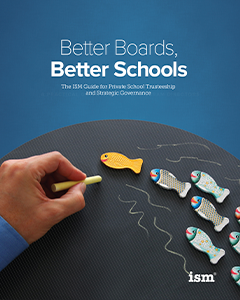1. Already a member? Click here to login.
2. Not a member? Click here to become a member.
3. Not sure? We’ll help you figure it out.


Volume 36
No. 7//
May 18, 2011
1. Already a member? Click here to login.
2. Not a member? Click here to become a member.
3. Not sure? We’ll help you figure it out.
Work with a trusted partner to create a mission-appropriate plan to help your school achieve its goals. Whether your school aims to increase cash reserves, boost enrollment levels, attain long-term stability, rely on experts to bring these goals and many others to life. Together we'll create and implement research-backed, personalized recommendations for any area of your school's administration. Call us at 302-656-4944 or email schoolsuccess@isminc.com.


Take an in-depth look at a particular subject through ISM's publications. You'll find ISM research, theory, and practices carefully outlined to support you in implementing recommended strategies within your school.

Boards can—and should—have excellent relationships with their Heads, and this book can help you solidify those relationships.
$31.95 General Price

Serving as a Trustee is a privilege that carries a substantial responsibility. Learn how to lead your school with a mission-driven, student-centered approach based on 45 years of ISM research and experience working with private school Boards.
Better Boards, Better Schools is your guide to ensuring your actions as a Trustee help fulfill your school’s mission. Empower the strategic functions of your Board so your school thrives today and in the years to come.
$31.95 General Price